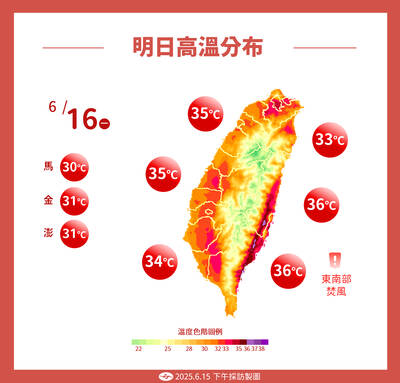The National Laboratory Animal Center yesterday unveiled a transgenic mouse species for early detection of drug-induced toxicity in the kidneys in a bid to help drugmakers reduce the toxicity of medicines at early stages of development.
While drugs are required to pass safety tests before entering the market, about 2 to 3 percent of newly approved drugs are recalled annually due to toxicity that is not detected previously, National Cheng Kung University (NCKU) Hospital nephrologist Chiou Yuan-yow (邱元佑) told a news conference in Taipei.
While high concentrations of metabolic waste products, such as creatinine and blood urea nitrogen, suggest the existence kidney disease, their concentrations can be stabilized with only 50 percent of the normal kidney function, meaning the substances are not reliable indicators of earlier kidney problems, said Chiou, also a researcher at the center.

Photo courtesy of the National Applied Research Laboratories
Urine protein is another indicator of kidney disease, but its concentration is likely affected by other dietary factors, he added.
While some international pharmaceutical firms had worked with the US, the EU and Japan to develop a method of using seven urine proteins to detect nephrotoxicity, each protein requires a testing reagent, and the method cannot entirely rule out nephrotoxicity, he said.
In an effort to create a more efficient tool to test nephrotoxicity, Chiou worked with researchers at the center and the university to develop a transgenic mouse species.
He first identified a biomarker named myo-inositol oxygenase (MIOX), an enzyme that is specific to the kidney and released from cells into serum and urine within 24 hours of kidney damage, he said.
As MIOX is not easily detected, the team utilized the center’s genetic modification techniques to add a luminescent enzyme called nanoluciferase (NanoLu) to the mice’s genes and enlarge its expressions, he said.
When a subject’s kidney was damaged, the nanoluciferase would be released into cells and enter serum or urine, allowing researchers to more clearly observe kidney damage, he said.
Over the past two years, the team has experimented with more than 100 mice to develop the transgenic species, Chiou said, adding that the new species is called MIOX-NanoLu transgenic mouse.
Pharmaceutical firms and researchers can use the mice as testing platforms to prevent their products from damaging the kidneys, he said.
The team published their findings in the journal Scientific Reports in August.
Ideally, the transgenic mice would act like the Taoist deity Shennong (神農, God of Herbs), who knows the toxicity of herbs by tasting them, center Director-General Genie Chin (秦咸靜) said.
The mice’s genetic material have been preserved at the center’s freezers, and it can breed the mice upon request, she said.
The animal center is one of the National Applied Research Laboratories’ eight centers.

Taiwan is to have nine extended holidays next year, led by a nine-day Lunar New Year break, the Cabinet announced yesterday. The nine-day Lunar New Year holiday next year matches the length of this year’s holiday, which featured six extended holidays. The increase in extended holidays is due to the Act on the Implementation of Commemorative and Festival Holidays (紀念日及節日實施條例), which was passed early last month with support from the opposition Chinese Nationalist Party (KMT) and Taiwan People’s Party. Under the new act, the day before Lunar New Year’s Eve is also a national holiday, and Labor Day would no longer be limited

Taiwan is to extend its visa-waiver program for Philippine passport holders for another year, starting on Aug. 1, Minister of Foreign Affairs Lin Chia-lung (林佳龍) said on Friday. Lin made the announcement during a reception in Taipei marking the 127th anniversary of Philippine independence and the 50th anniversary of the establishment of the Manila Economic and Cultural Office (MECO) in Taiwan, the Ministry of Foreign Affairs said. The decision reflected Taiwan’s commitment to deepening exchanges with the Philippines, the statement cited Lin as saying, adding that it was a key partner under the New Southbound Policy launched in 2016. Lin also expressed hope

Costa Rica sent a group of intelligence officials to Taiwan for a short-term training program, the first time the Central American country has done so since the countries ended official diplomatic relations in 2007, a Costa Rican media outlet reported last week. Five officials from the Costa Rican Directorate of Intelligence and Security last month spent 23 days in Taipei undergoing a series of training sessions focused on national security, La Nacion reported on Friday, quoting unnamed sources. The Costa Rican government has not confirmed the report. The Chinese embassy in Costa Rica protested the news, saying in a statement issued the same

Temperatures in New Taipei City’s Sindian District (新店) climbed past 37°C yesterday, as the Central Weather Administration (CWA) issued heat alerts for 16 municipalities, warning the public of intense heat expected across Taiwan. The hottest location in Taiwan was in Sindian, where the mercury reached 37.5°C at about 2pm, according to CWA data. Taipei’s Shilin District (士林) recorded a temperature of 37.4°C at noon, Taitung County’s Jinfeng Township (金峰) at 12:50 pm logged a temperature of 37.4°C and Miaoli County’s Toufen Township (頭份) reached 36.7°C at 11:40am, the CWA said. The weather agency yesterday issued a yellow level information notice for Taipei, New